Potential Elements of Green Infrastructure (PeGI) Inside the Core of the Village (CoV): A Case Study of Wrocław Functional Area (WFA) in Poland
Abstract
:1. Introduction
2. Materials and Methods
2.1. Study Area
2.2. The Green Infrastructure System Project in the Wrocław Functional Area (GI WFA)
2.3. Method
2.3.1. STAGE I Preliminary/General Study: STAGE IA Identification of GI Elements in the Villages
- (a)
- location with respect to the CoV; i.e., their location inside or outside the CoV,
- (b)
- form (linear or areal-type),
- (c)
- accessibility/ownership (unrestricted, limited, not accessible) [66]. The term possibility of entering indicates whether the area was a public space (with it being fully possible to enter), a semi-public or private space (with only a partial possibility of entering; e.g., school, sanatorium) or a private property without the possibility of entering.
- (a)
- Located inside the CoV of individual villages,
- (b)
- Owned by a municipality or religious community; i.e., unrestricted or only limited accessibility/ownership. These were either public (with full access) or semi-public and private areas with partial access, shared by the inhabitants of a given village or visitors, such as tourists. Such a criterion is important, because the current and future development of these areas depends to a large extent on proper municipal spatial policies. Parks and water reservoirs were exceptions, where neither the possibility of entering nor the form of ownership were taken into account. The selection of elements for detailed research did not take into consideration green areas located on private plots of land, nor plots with residential or industrial functions.
- (4) Parks and squares. Parks (4a,b)and squares (4c);
- (5) Areas accompanying public facilities. Areas located near places of worship (temples) (5a) and schools/kindergartens (5b) and areas next to cultural facilities (e.g., community centers) (5d);
- (6) Recreational and sports areas. Recreation areas (6a), sports fields (6b), and playgrounds (6c);
- (7) Cemeteries. Operating cemeteries (7a) and non-operating/closed cemeteries (7b);
- (9) Green areas accompanying communication routes (e.g., avenues, lanes of trees). Green areas accompanying the main thoroughfares in the villages (9a);
- (11) Water surface area. Water reservoirs/ponds (11b,c) and watercourses (11d,f) with their immediate surroundings.
2.3.2. STAGE I Preliminary/General Study, STAGE IB Selection of Villages
2.3.3. STAGE II Principal/Detailed Study: Analysis of Selected Villages
- The past (the early 20th century), on the basis of historical topographic maps from the beginning of the 20th century drawn at a scale of 1:25,000 (messtischblatt), available online: http://mapy.amzp.pl/ (accessed on 30 December 2021);
- The present (the early 21st century), based on contemporary topographic maps; orthophotomaps, available online: https://geoportal.dolnyslask.pl/(accessed on 30 December 2021);
- The future adopting a period of between a dozen or so and several dozen years, based on planning studies—Local Spatial Development Plans (LSDPs) available at the Lower Silesian regional website https://geoportal.dolnyslask.pl/start/ (accessed on 30 December 2021), the national website https://www.geoportal.gov.pl/ (accessed on 30 December 2021) and the Spatial Information System of Wrocław County (WroSiP) https://www.wrosip.pl/ (accessed on 30 December 2021). Ownership structure was also examined to identify land owned by municipalities, counties or religious communities.
3. Results
3.1. Past (Early 20th Century)
3.2. Present (Early 21st Century)
3.3. Future—Village Development Plans
3.4. Comparative Analysis
4. Discussion
4.1. PeGI Classification and CoV Selection
4.2. Identification and Analysis of PeGI Inside CoVs
5. Conclusions
- The proposed approach to GI research is of a specific and original character, as it relates to the boundaries of CoVs and to the PeGI systems. The potential of PeGIs results not only from their current natural assets but also from the possibility of changing their management in the future. Consequently, through appropriate planning, design and management, PeGI are able to become multifunctional elements of regional GI networks.
- It would be valuable for future research on rural and peri-urban areas to adopt the definition of CoV presented in this paper, as well as its delimitations (including the way of defining its boundaries). The concept of a CoV is essential for future rural studies, as it will enable comparative analyses of other localities, not only in Poland but also in other countries. At the same time, it will prevent discrepancies that may arise from use of the more general and ambiguous term village.
- The presented study focused on a selection of PeGIs comprising public and semi-public areas, their identification in relation to CoVs and an analysis of location and durability. Durability was defined as structural stability, measured in terms of PeGI presence throughout the past (early 20th century), present and future CoVs. The PeGIs of a public and semi-public character in the CoV included parks, squares, cemeteries, areas adjacent to public facilities and roadside greenery. The findings indicate that parks are among the most durable PeGI elements, i.e., still present in the CoV landscape today and included in future plans. In contrast, the least durable PeGI was found to be the greenery along roads. It was also found that at the beginning of the 20th century, in the CoVs analyzed, there were linear PeGIs (avenues and rows) connecting PeGIs of an areal character.
- Unfortunately, it was found that current planning documents do not take the structure and connectivity of PeGI in the CoV into consideration Moreover, despite the growth of built-up areas, there are also no provisions in place for the proportional growth of PeGI, nor are there considerations regarding their potential connections to external PeGIs. The investigations revealed that, even the connections that do exist are separated by built-up areas and are being pushed away from CoV boundaries. This poses a particular threat to the GI network, particularly in peri-urban areas, which are constantly being exposed to strong pressure from new forms of development, including built-up empty spaces.
- Ultimately, this study has demonstrated that it would be possible to create a network inside CoVs on the basis of existing PeGI, especially since these are often historic elements and structures, which in many places would facilitate not only the creation of new kinds of greenery but also the restoration of historic forms. To strengthen the structural connectivity of the GI network, it would be advisable to modify existing development plans and to undertake transformations in situ, through the implementation of appropriate projects and in cooperation with villagers and other stakeholders.
Author Contributions
Funding
Institutional Review Board Statement
Informed Consent Statement
Data Availability Statement
Conflicts of Interest
References
- Pauleit, S.; Ambrose, B.; Endersson, E.; Anton Buijs, A.; Haase, D.; Elands, B.; Hansen, R.; Kowarik, I.; Kronenburg, J.; Mattijssen, T.; et al. Advancing urban green infrastructure in Europe: Outcomes and reflections from the GREEN SURGE project. Urban For. Urban Green. 2019, 40, 4–16. [Google Scholar] [CrossRef]
- Seiwert, A.; Rößler, S. Understanding the term green infrastructure: Origins, rationales, semantic content and purposes as well as its relevance for application in spatial planning. Land Use Policy 2020, 97, 104785. [Google Scholar] [CrossRef]
- Chang, Q.; Li, X.; Huang, X.; Wu, J. A GIS-based Green Infrastructure Planning for Sustainable Urban Land Use and Spatial Development. Procedia Environ. Sci. 2012, 12, 491–498. [Google Scholar] [CrossRef] [Green Version]
- Demuzere, M.; Orru, K.; Heidrich, O.; Olazabal, E.; Geneletti, D.; Orru, H.; Bhave, A.G.; Mittal, N.; Feliu, E.; Faehnle, M. Mitigating and adapting to climate change: Multi-functional and multi-scale assessment of green urban infrastructure. J. Environ. Manag. 2014, 146, 107–115. [Google Scholar] [CrossRef]
- Gill, S.E.; Handley, J.F.; Ennos, A.R.; Pauleit, S. Adapting Cities for Climate Change: The Role of the Green Infrastructure. Built Environ. 2007, 33, 115–133. [Google Scholar] [CrossRef] [Green Version]
- Norton, B.A.; Coutts, A.M.; Livesley, S.J.; Harris, R.J.; Hunter, A.M.; Williams, N.S.G. Planning for cooler cities: A framework to prioritise green infrastructure to mitigate high temperatures in urban landscapes. Landsc. Urban Plan. 2015, 134, 127–138. [Google Scholar] [CrossRef]
- Sussams, L.; Sheate, W.; Eales, R. Green infrastructure as a climate change adaptation policy intervention: Muddying the waters or clearing a path to a more secure future? J. Environ. Manag. 2015, 147, 184–193. [Google Scholar] [CrossRef]
- Benedict, M.A.; McMahon, E.T. Green Infrastructure: Smart Conservation for the 21st Century. Renew. Resour. J. 2002, 20, 12–17. [Google Scholar]
- European Commission (EC). The European Biodiversity Strategy 2030: Bringing Nature Back into Our Lives; European Commission: Brussels, Belgium, 2020; Available online: https://eur-lex.europa.eu/legal-content/EN/TXT/?qid=1590574123338&uri=CELEX:52020DC0380 (accessed on 20 January 2022).
- European Commission. Directorate General for the Environment. Building a Green Infrastructure for Europe; Publications Office: Luxembourg, 2014; Available online: https://data.europa.eu/doi/10.2779/54125 (accessed on 20 January 2022).
- European Commission. Directorate-General for Environment, the European Green Deal; Publications Office: Brussels, Belgium, 2019; Available online: https://eur-lex.europa.eu/legal-content/EN/TXT/?qid=1576150542719&uri=COM%3A2019%3A640%3AFIN (accessed on 20 January 2022).
- Amati, M.; Taylor, L. From Green Belts to Green Infrastructure. Plan. Pr. Res. 2010, 25, 143–155. [Google Scholar] [CrossRef]
- Cieszewska, A. Green Belts. Zielone Pierścienie Wielkich Miast (Green Belts. Green Rings of Big Cities); SEDNO Wydawnictwo Akademickie: Warszawa, Poland, 2019. (In Polish) [Google Scholar]
- De Oliveira, F.L. Green Wedge Urbanism: History, Theory and Contemporary Practice; Bloomsbury Academic: New York, NY, USA, 2017. [Google Scholar]
- European Environmental Agency. Urban Sprawl in Europe. The Ignored Challenge; Technical Report No. 10/2006; Office for Official Publications of the European Communities: Luxembourg, 2006; Available online: https://www.eea.europa.eu/publications/eea_report_2006_10/eea_report_10_2006.pdf (accessed on 12 December 2021).
- Hennig, E.I.; Schwick, C.; Soukup, T.; Orlitová, E.; Kienast, F.; Jaeger, J.A. Multi-scale analysis of urban sprawl in Europe: Towards a European de-sprawling strategy. Land Use Policy 2015, 49, 483–498. [Google Scholar] [CrossRef] [Green Version]
- Robinson, D.T. Land-cover fragmentation and configuration of ownership parcels in an exurban landscape. Urban Ecosyst. 2012, 15, 53–69. [Google Scholar] [CrossRef]
- Bittner, C.; Sofer, M. Land use changes in the rural–urban fringe: An Israeli case study. Land Use Policy 2013, 33, 11–19. [Google Scholar] [CrossRef]
- Ravetz, J.; Fertner, C.; Nielsen, T.S. The Dynamics of Peri-Urbanization. In Peri-Urban Futures: Scenarios and Models for Land Use Change in Europe; Nilsson, K., Pauleit, S., Bell, S., Aalbers, C., Nielsen, T.S., Eds.; Springer: Berlin/Heidelberg, Germany, 2013; pp. 13–44. [Google Scholar]
- Kovács, Z.; Farkas, J.Z.; Egedy, T.; Kondor, A.C.; Szabó, B.; Lennert, J.; Baka, D.; Kohán, B. Urban sprawl and land conversion in post-socialist cities: The case of metropolitan Budapest. Cities 2019, 92, 71–81. [Google Scholar] [CrossRef]
- Spyra, M.; Inostroza, L.; Hamerla, A.; Bondaruk, J. Ecosystem services deficits in cross-boundary landscapes: Spatial mismatches between green and grey systems. Urban Ecosyst. 2018, 22, 37–47. [Google Scholar] [CrossRef]
- Tian, Y.; Zhou, D.; Jiang, G. Conflict or Coordination? Multiscale assessment of the spatio-temporal coupling relationship between urbanization and ecosystem services: The case of the Jingjinji Region, China. Ecol. Indic. 2020, 117, 106543. [Google Scholar] [CrossRef]
- Liu, J.; Daily, G.C.; Ehrlich, P.R.; Luck, G.W. Effects of household dynamics on resource consumption and biodiversity. Nature 2003, 421, 530–533. [Google Scholar] [CrossRef]
- Mckinney, M.L. Urbanization, Biodiversity, and ConservationThe impacts of urbanization on native species are poorly studied, but educating a highly urbanized human population about these impacts can greatly improve species conservation in all ecosystems. BioScience 2002, 52, 883–890. [Google Scholar] [CrossRef]
- Pauleit, S.; Liu, L.; Ahern, J.; Kazmierczak, A. Multifunctional green infrastructure planning to promote ecological services in the city. In Urban Ecology. Patterns, Processes and Applications, 2nd ed.; Niemelä, J., Breuste, J.H., Huntenspergen, G., McIntyre, N.E., Elmqvist, T., James, P., Eds.; Oxford University Press: Oxford, UK, 2011. [Google Scholar] [CrossRef]
- Rolf, W.; Pauleit, S.; Wiggering, H. A stakeholder approach, door opener for farmland and multifunctionality in urban green infrastructure. Urban For. Urban Green. 2019, 40, 73–83. [Google Scholar] [CrossRef]
- Wang, J.; Banzhaf, E. Towards a better understanding of Green Infrastructure: A critical review. Ecol. Indic. 2018, 85, 758–772. [Google Scholar] [CrossRef]
- Benedict, M.A.; McMahon, E.T. Green infrastructure. Linking Landscapes and Communities; Island Press: Washington, DC, USA, 2006. [Google Scholar]
- Hodgson, J.A.; Thomas, C.D.; Wintle, B.A.; Moilanen, A. Climate change, connectivity and conservation decision making: Back to basics. J. Appl. Ecol. 2009, 46, 964–969. [Google Scholar] [CrossRef]
- Krosby, M.; Tewksbury, J.; Haddad, N.M.; Hoekstra, J. Ecological Connectivity for a Changing Climate. Conserv. Biol. 2010, 24, 1686–1689. [Google Scholar] [CrossRef] [PubMed]
- Bierwagen, B.G. Connectivity in urbanizing landscapes: The importance of habitat configuration, urban area size, and dispersal. Urban Ecosyst. 2007, 10, 29–42. [Google Scholar] [CrossRef]
- Elmqvist, T.; Zipperer, W.C.; Güneralp, B. Urbanization, habitat loss and biodiversity decline: Solution pathways to break the cycle. In The Routledge Handbook of Urbanization and Global Environmental Change; Seto, K.C., Solecki, W.D., Griffith, C.A., Eds.; Taylor and Francis: London, UK, 2015; pp. 139–151. [Google Scholar]
- Zeller, K.; Lewison, R.; Fletcher, R.; Tulbure, M.; Jennings, M. Understanding the Importance of Dynamic Landscape Connectivity. Land 2020, 9, 303. [Google Scholar] [CrossRef]
- Fletcher, R.J.; Burrell, N.S.; Reichert, B.E.; Vasudev, D.; Austin, J.D. Divergent Perspectives on Landscape Connectivity Reveal Consistent Effects from Genes to Communities. Curr. Landsc. Ecol. Rep. 2016, 1, 67–79. [Google Scholar] [CrossRef] [Green Version]
- Aurambout, J.-P.; Barranco, R.; LaValle, C. Towards a Simpler Characterization of Urban Sprawl across Urban Areas in Europe. Land 2018, 7, 33. [Google Scholar] [CrossRef] [Green Version]
- Liu, Z.; Robinson, G.M. Residential development in the peri-urban fringe: The example of Adelaide, South Australia. Land Use Policy 2016, 57, 179–192. [Google Scholar] [CrossRef]
- Tanaś, J.; Trojanek, M. Changes in land use structure in suburban zones in Poland after the 90. J. Int. Stud. 2014, 7, 81–89. [Google Scholar] [CrossRef] [PubMed]
- Grochowski, M.; Korcelli, P.; Kozubek, E.; Sławiński, T.; Werner, P. Warsaw: Spatial Growth with Limited Control. In Peri-Urban Futures: Scenarios and Models for Land Use Change in Europe; Nilsson, K., Pauleit, S., Bell, S., Aalbers, C., Nielsen, T.S., Eds.; Springer: Berlin/Heidelberg, Germany, 2013; pp. 131–167. [Google Scholar]
- Tokarczyk-Dorociak, K.; Kazak, J.; Szewranski, S. The Impact of a Large City on Land Use in Suburban Area—The Case of Wrocław (Poland). J. Ecol. Eng. 2018, 19, 89–98. [Google Scholar] [CrossRef]
- Commission Delegated Regulation 2019/1755. Available online: https://eur-lex.europa.eu/legal-content/EN/TXT/?qid=1571919890809&uri=CELEX:32019R1755 (accessed on 22 November 2021).
- Cambridge Dictionary. Available online: https://dictionary.cambridge.org/pl/dictionary/english-polish/village (accessed on 23 November 2021).
- Journal of Laws 2003 No. 166, Item 1612 of the Act of 29 August 2003 on Official Names of Towns and Physiographic Objects. Available online: http://isap.sejm.gov.pl/isap.nsf/DocDetails.xsp?id=wdu20031661612 (accessed on 23 February 2021).
- Woods, M. Rural geography: Blurring boundaries and making connections. Prog. Hum. Geogr. 2009, 33, 849–858. [Google Scholar] [CrossRef]
- Wójcik, M. Territorial Identity of Countryside Residents in the Suburban Areas of Łódź, Poland. Quaest. Geogr. 2013, 32, 69–79. [Google Scholar] [CrossRef] [Green Version]
- Rolf, W.; Peters, D.; Lenz, R.; Pauleit, S. Farmland—An Elephant in the Room of Urban Green Infrastructure? Lessons learned from connectivity analysis in three German cities. Ecol. Indic. 2018, 94, 151–163. [Google Scholar] [CrossRef]
- Solecka, I.; Sylla, M.; Świąder, M. Urban Sprawl Impact on Farmland Conversion in the Suburban Area of Wroclaw, Poland. IOP Conf. Ser. Mater. Sci. Eng. 2017, 245, 072002. [Google Scholar] [CrossRef]
- Spyra, M.; Kleemann, J.; Calò, N.C.; Schürmann, A.; Fürst, C. Protection of peri-urban open spaces at the level of regional policy-making: Examples from six European regions. Land Use Policy 2021, 107, 105480. [Google Scholar] [CrossRef]
- Lin, Y.; Shui, W.; Li, Z.; Huang, S.; Wu, K.; Sun, X.; Liang, J. Green space optimization for rural vitality: Insights for planning and policy. Land Use Policy 2021, 108, 105545. [Google Scholar] [CrossRef]
- Baró, F.; Gómez-Baggethun, E.; Haase, D. Ecosystem service bundles along the urban-rural gradient: Insights for landscape planning and management. Ecosyst. Serv. 2017, 24, 147–159. [Google Scholar] [CrossRef] [Green Version]
- Antrop, M. Rural-urban conflicts and opportunities. In Presented at the Frontis Workshop on New Dimensions of the European Landscape; Wageningen, U.R., Frontis, S., Jongman, R., Eds.; Springer: Dordrecht, The Netherlands, 2004; pp. 83–91. [Google Scholar]
- Torreggiani, D.; Ludwiczak, Z.; Dall’Ara, E.; Benni, S.; Maino, E.; Tassinari, P. TRuLAn: A high-resolution method for multi-time analysis of traditional rural landscapes and its application in Emilia-Romagna, Italy. Landsc. Urban Plan. 2014, 124, 93–103. [Google Scholar] [CrossRef]
- Gant, R.L.; Robinson, G.M.; Fazal, S. Land-use change in the ‘edgelands’: Policies and pressures in London’s rural–urban fringe. Land Use Policy 2011, 28, 266–279. [Google Scholar] [CrossRef]
- Warczewska, B. System przyrodniczy Wrocławskiego Obszaru Funkcjonalnego (The natural environment system of the Wroclaw Functional Area). Studia Miej. 2016, 22, 143–153. [Google Scholar]
- Raport o Stanie Gminy 2019 (Report on the State of the Municipality 2019). Available online: www.wroclaw.pl/portal/files/dokumenty/30060/Raport_o_stanie_gminy_2019.pdf (accessed on 1 March 2021).
- Koncepcja Przestrzennego Zagospodarowania Kraju 2030 (Concept of National Spatial Planning 2030). Available online: http://prawo.sejm.gov.pl/isap.nsf/download.xsp/WMP20120000252/O/M20120252-1.pdf (accessed on 20 September 2021).
- Zagrzejewska-Fiedorowicz, M.; Tutaj, J.; Bąk, R.; Drożdż, W.; Dendewicz, S. IPPON–Studium Integracji Przestrzennej Polskiej Części Pogranicza Polski i Niemiec; Ministry of Regional Development: Warszawa, Poland, 2013; ISBN 978-83-7610-444-7. Available online:; (accessed on 20 December 2021). [Google Scholar]
- Girul, A.; Guzek, P. Uwarunkowania społeczne, gospodarcze i przestrzenne Wrocławskiego Obszaru Funkcjonalnego w 2018 r. (Social, Economic and Spatial Conditions of the Wrocław Functional Area in 2018); Urząd Statystyczny we Wrocławiu: Wrocław, Poland, 2018; Available online: https://zitwrof.pl/wp-content/uploads/2020/01/wroclawski_zit1.pdf (accessed on 12 December 2021).
- Markowski, T. Ekonomiczny wymiar urbanizacji (The economic dimension of urbanization). In Przestrzeń życia Polaków (Living space of Poles); Sepioł, J., Ed.; Stowarzyszenie Architektów Polskich SARP: Warszawa, Poland, 2014; pp. 125–138. (In Polish) [Google Scholar]
- Śleszyński, P.; Deręgowska, A.; Kubiak, Ł.; Sudra, P.; Zielińska, B. Analiza Stanu i Uwarunkowań Prac Planistycznych w Gminach w 2017 Roku (Analysis of the State and Conditions of Planning Work in Municipalities in 2017); Instytut Geografii i Przestrzennego Zagospodarowania PAN: Warszawa, Poland, 2018; Available online: https://www.igipz.pan.pl/aktualnosc/items/analiza-stanu-2017.html?file=tl_files/igipz/instytut/aktualnosci/analiza_stanu_2017/Analiza_stanu_2017.pdf (accessed on 12 October 2021).
- Study of the Functional Coherence in the Wrocław Functional Area, 2015/Studium Spójności Funkcjonalnej We Wrocławskim Obszarze Funkcjonalnym. 2015. Available online: http://www.powiatwroclawski.pl/web/uploads/pub/news/news_2458/epub.pdf (accessed on 12 December 2021).
- Niedźwiecka-Filipiak, I.; Potyrała, J.; Filipiak, P. Contemporary management of green infrastructure within the borders of Wrocław Functional Area (WFA). Landsc. Archit. 2015, 47, 4–27. Available online: http://architekturakrajobrazu.up.wroc.pl/images/Nied%C5%BAwiecka-Filipiak_Potyra%C5%82a_Filipiak.pdf (accessed on 12 December 2021).
- Niedźwiecka-Filipiak, I.; Rubaszek, J.; Potyrała, J.; Filipiak, P. The Method of Planning Green Infrastructure System with the Use of Landscape-Functional Units (Method LaFU) and its Implementation in the Wrocław Functional Area (Poland). Sustainability 2019, 11, 394. [Google Scholar] [CrossRef] [Green Version]
- Weber, T.; Sloan, A.; Wolf, J. Maryland’s Green Infrastructure Assessment: Development of a comprehensive approach to land conservation. Landsc. Urban Plan. 2006, 77, 94–110. [Google Scholar] [CrossRef]
- Shi, X.; Qin, M. Research on the Optimization of Regional Green Infrastructure Network. Sustainability 2018, 10, 4649. [Google Scholar] [CrossRef] [Green Version]
- Dupras, J.; Drouin, C.; André, P.; Gonzalez, A. Towards the Establishment of a Green Infrastructure in the Region of Montreal (Quebec, Canada). Plan. Pr. Res. 2015, 30, 355–375. [Google Scholar] [CrossRef]
- Koc, C.B.; Osmond, P.; Peters, A. Towards a comprehensive green infrastructure typology: A systematic review of approaches, methods and typologies. Urban Ecosyst. 2017, 20, 15–35. [Google Scholar] [CrossRef]
- Davies, C.; McGloin, C.; MacFarlane, R.; Roe, M. Green Infrastructure Planning Guide. 2015. Available online: https://www.researchgate.net/publication/265012095_GREEN_INFRASTRUCTURE_PLANNING_GUIDE_Authors (accessed on 12 December 2021).
- Young, R.; Zanders, J.; Lieberknecht, K.; Fassman-Beck, E. A comprehensive typology for mainstreaming urban green infrastructure. J. Hydrol. 2014, 519, 2571–2583. [Google Scholar] [CrossRef]
- European Environment Agency. Green Infrastructure and Territorial Cohesion. The Concept of Green Infrastructure and Its Integration into Policies Using Monitoring Systems. Technical Report No. 18/2011. Available online: https://www.eea.europa.eu/publications/green-infrastructure-and-territorial-cohesion (accessed on 12 December 2021).
- European Environment Agency. Spatial Analysis of Green Infrastructure in Europe; Technical Report No 2/2014; Publications Office of the European Union: Luxembourg, 2014. [Google Scholar] [CrossRef]
- Central Statistical Office. Obszary Wiejskie w Polsce w 2018 Roku (Rural Areas in Poland in 2018); Warszawa: Olsztyn, Poland, 2018. Available online: https://stat.gov.pl/download/gfx/portalinformacyjny/pl/defaultaktualnosci/5507/2/4/1/obszary_wiejskie_w_polsce_w_2018_r.pdf (accessed on 2 March 2021).
- Monuments Register of the Lower Silesian Province (Wykaz zabytków Województwa Dolnośląskiego). Available online: https://wosoz.ibip.wroc.pl/public/?id=92697 (accessed on 10 May 2021).
- Hansen, R.; Pauleit, S. From Multifunctionality to Multiple Ecosystem Services? A Conceptual Framework for Multifunctionality in Green Infrastructure Planning for Urban Areas. AMBIO 2014, 43, 516–529. [Google Scholar] [CrossRef] [Green Version]
- Lafortezza, R.; Davies, C.; Sanesi, G.; Konijnendijk, C. Green Infrastructure as a tool to support spatial planning in European urban regions. iForest-Biogeosci. For. 2013, 6, 102–108. [Google Scholar] [CrossRef] [Green Version]
- Mell, I. Green infrastructure: Reflections on past, present and future praxis. Landsc. Res. 2017, 42, 135–145. [Google Scholar] [CrossRef] [Green Version]
- Fan, P.; Xu, L.; Yue, W.; Chen, J. Accessibility of public urban green space in an urban periphery: The case of Shanghai. Landsc. Urban Plan. 2017, 165, 177–192. [Google Scholar] [CrossRef]
- Zhang, J.; Cheng, Y.; Zhao, B. How to accurately identify the underserved areas of peri-urban parks? An integrated accessibility indicator. Ecol. Indic. 2021, 122, 107263. [Google Scholar] [CrossRef]
- Žlender, V.; Thompson, C.W. Accessibility and use of peri-urban green space for inner-city dwellers: A comparative study. Landsc. Urban Plan. 2017, 165, 193–205. [Google Scholar] [CrossRef] [Green Version]
- Xu, C.; Haase, D.; Pauleit, S. The impact of different urban dynamics on green space availability: A multiple scenario modeling approach for the region of Munich, Germany. Ecol. Indic. 2018, 93, 1–12. [Google Scholar] [CrossRef]
- Conedera, M.; Del Biaggio, A.; Seeland, K.; Moretti, M.; Home, R. Residents’ preferences and use of urban and peri-urban green spaces in a Swiss mountainous region of the Southern Alps. Urban For. Urban Green. 2015, 14, 139–147. [Google Scholar] [CrossRef]
- Loram, A.; Tratalos, J.; Warren, P.H.; Gaston, K.J. Urban domestic gardens (X): The extent & structure of the resource in five major cities. Landsc. Ecol. 2007, 22, 601–615. [Google Scholar] [CrossRef]
- Journal of Laws 2003 No. 80 Item 717, as Amended of the Act on Spatial Planning and Development. Available online: https://isap.sejm.gov.pl/isap.nsf/DocDetails.xsp?id=WDU20030800717 (accessed on 30 December 2021).
- Journal of Laws 2016, Item 446, as Amended of the Act on the Commune Self-Government. 2021. Available online: https://isap.sejm.gov.pl/isap.nsf/download.xsp/WDU19900160095/U/D19900095Lj.pdf (accessed on 30 December 2021).
- Garau, C.; Desogus, G.; Maltinti, F.; Olivo, A.; Peretti, L.; Coni, M. Practices for an Integrated Planning Between Urban Planning and Green Infrastructures for the Development of the Municipal Urban Plan (MUP) of Cagliari (Italy). In Lecture Notes in Computer Science; Springer: Singapore, 2021; pp. 3–18. [Google Scholar]
- Woodruff, S.; Bae, J.; Sohn, W.; Newman, G.; Tran, T.; Lee, J.; Wilkins, C.; Van Zandt, S.; Ndubisi, F. Planning, development pressure, and change in green infrastructure quantity and configuration in coastal Texas. Land Use Policy 2021, 114, 105893. [Google Scholar] [CrossRef]
- Rudorff, E. Heimatschutz; Müller: Munich, Germany, 1897. [Google Scholar]
- Nowosielska-Sobel, J. O Ziemi Rodzinnej ku Ojczyźnie Ideologicznej. Ruch Ochrony Stron Ojczystych (Heimatschutz) ze Szczególnym Uwzględnieniem Śląska (1871–1933) (From the Family Land to the Ideological Homeland. Homeland Protection Movement (Heimatschutz) with Particular Emphasis on Silesia (1871–1933); Wydawnictwo Uniwersytetu Wrocławskiego: Wrocław, Poland, 2013. (In Polish) [Google Scholar]
- Jaworek-Jakubska, J. “As masterly as very few others are…”—The polish gardens of Peter Joseph Lenné. An example of Polish-German study into the history and maintenance of historical garden. Czas. Tech. 2019, 10, 5–20. [Google Scholar] [CrossRef]
- Köhler, M.; Haase, C. Die Gärten Peter Joseph Lennés im Heutigen Polen Eine Spurensuche Jenseits von Oder und Neiße; Verlag Janos Stekovics: Wettin-Löbejün, Germany, 2016. [Google Scholar]
- Podolska, A. Zadrzewienia liniowe w strefie podmiejskiej Wrocławia (Alleys In The Suburban Area Of Wrocław). Nauka Przyr. Technol. 2013, 7, 28. Available online: http://www.npt.up-poznan.net/pub/art_7_28.pdf (accessed on 12 December 2021).
- LaPoint, S.; Balkenhol, N.; Hale, J.; Sadler, J.; Van Der Ree, R. Ecological connectivity research in urban areas. Funct. Ecol. 2015, 29, 868–878. [Google Scholar] [CrossRef]
- Taylor, P.D.; Fahrig, L.; Henein, K.; Merriam, G. Connectivity Is a Vital Element of Landscape Structure. Oikos 1993, 68, 571. [Google Scholar] [CrossRef] [Green Version]
- Tortora, A.; Statuto, D.; Picuno, P. Rural landscape planning through spatial modelling and image processing of historical maps. Land Use Policy 2015, 42, 71–82. [Google Scholar] [CrossRef]
- Li, X.; Zhang, C.; Li, W.; Ricard, R.; Meng, Q.; Zhang, W. Assessing street-level urban greenery using Google Street View and a modified green view index. Urban For. Urban Green. 2015, 14, 675–685. [Google Scholar] [CrossRef]
- Lu, Y. The Association of Urban Greenness and Walking Behavior: Using Google Street View and Deep Learning Techniques to Estimate Residents’ Exposure to Urban Greenness. Int. J. Environ. Res. Public Health 2018, 15, 1576. [Google Scholar] [CrossRef] [PubMed] [Green Version]
- Ye, Y.; Richards, D.; Lu, Y.; Song, X.; Zhuang, Y.; Zeng, W.; Zhong, T. Measuring daily accessed street greenery: A human-scale approach for informing better urban planning practices. Landsc. Urban Plan. 2019, 191, 103434. [Google Scholar] [CrossRef]
- Zhang, Z.; Meerow, S.; Newell, J.P.; Lindquist, M. Enhancing landscape connectivity through multifunctional green infrastructure corridor modeling and design. Urban For. Urban Green. 2019, 38, 305–317. [Google Scholar] [CrossRef]
- Klemm, W.; Heusinkveld, B.G.; Lenzholzer, S.; van Hove, B. Street greenery and its physical and psychological impact on thermal comfort. Landsc. Urban Plan. 2015, 138, 87–98. [Google Scholar] [CrossRef]
- Webber, J.L.; Fletcher, T.D.; Cunningham, L.; Fu, G.; Butler, D.; Burns, M.J. Is green infrastructure a viable strategy for managing urban surface water flooding? Urban Water J. 2020, 17, 598–608. [Google Scholar] [CrossRef] [Green Version]
- Rosin, Z.M.; Hiron, M.; Żmihorski, M.; Szymański, P.; Tobolka, M.; Pärt, T. Reduced biodiversity in modernized villages: A conflict between sustainable development goals. J. Appl. Ecol. 2020, 57, 467–475. [Google Scholar] [CrossRef]
- Hiron, M.; Berg, Å.; Eggers, S.; Pärt, T. Are farmsteads over-looked biodiversity hotspots in intensive agricultural ecosystems? Biol. Conserv. 2013, 159, 332–342. [Google Scholar] [CrossRef]
- Lumsden, L.F.; Bennett, A.F. Scattered trees in rural landscapes: Foraging habitat for insectivorous bats in south-eastern Australia. Biol. Conserv. 2005, 122, 205–222. [Google Scholar] [CrossRef]
- Gormus, S.; Cengiz, S.; Tagil, S. Proposing an agricultural belt to protect a city’s semi-rural characteristics: The example of Bartın, Turkey. Landsc. Res. 2018, 44, 557–573. [Google Scholar] [CrossRef]
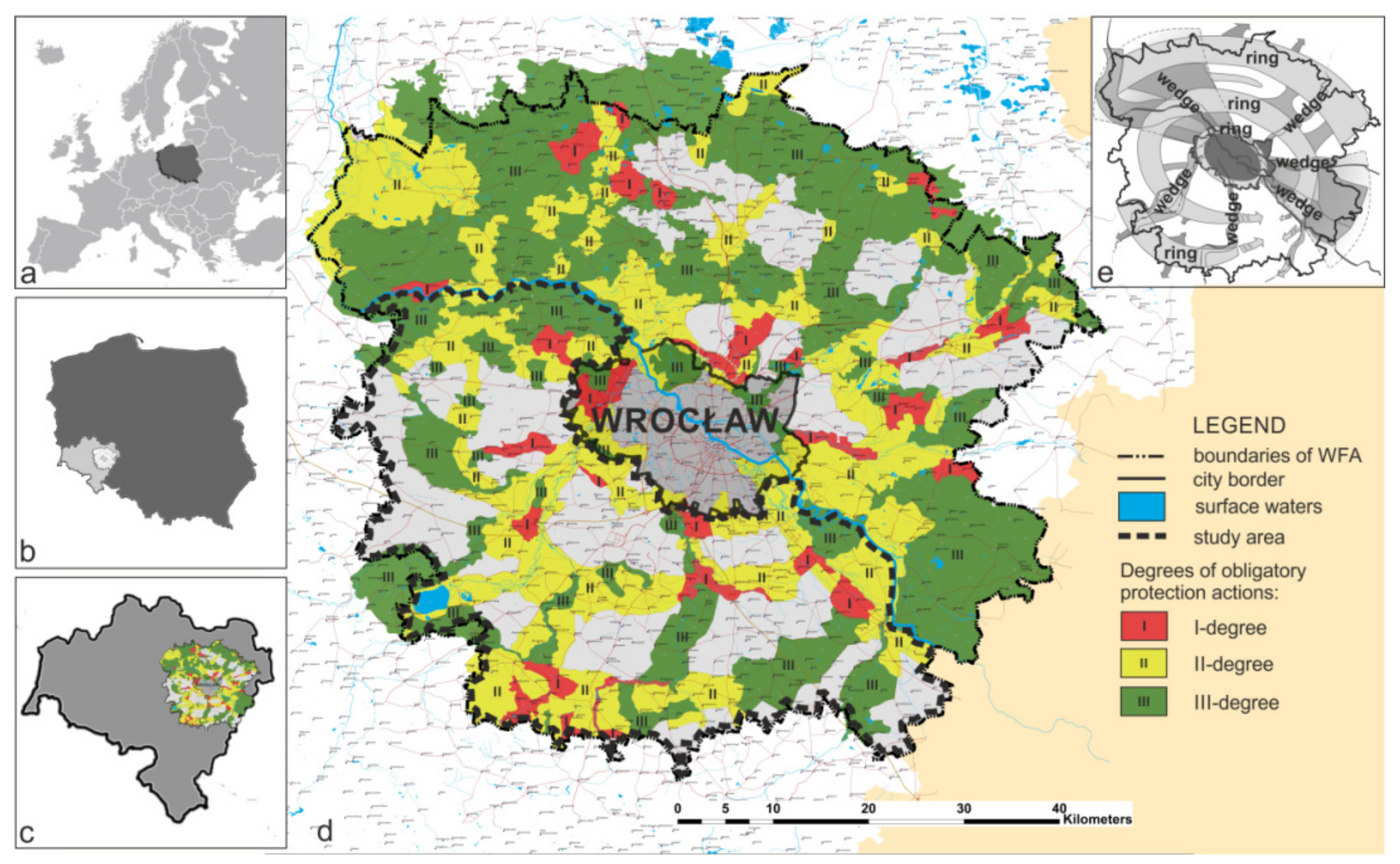
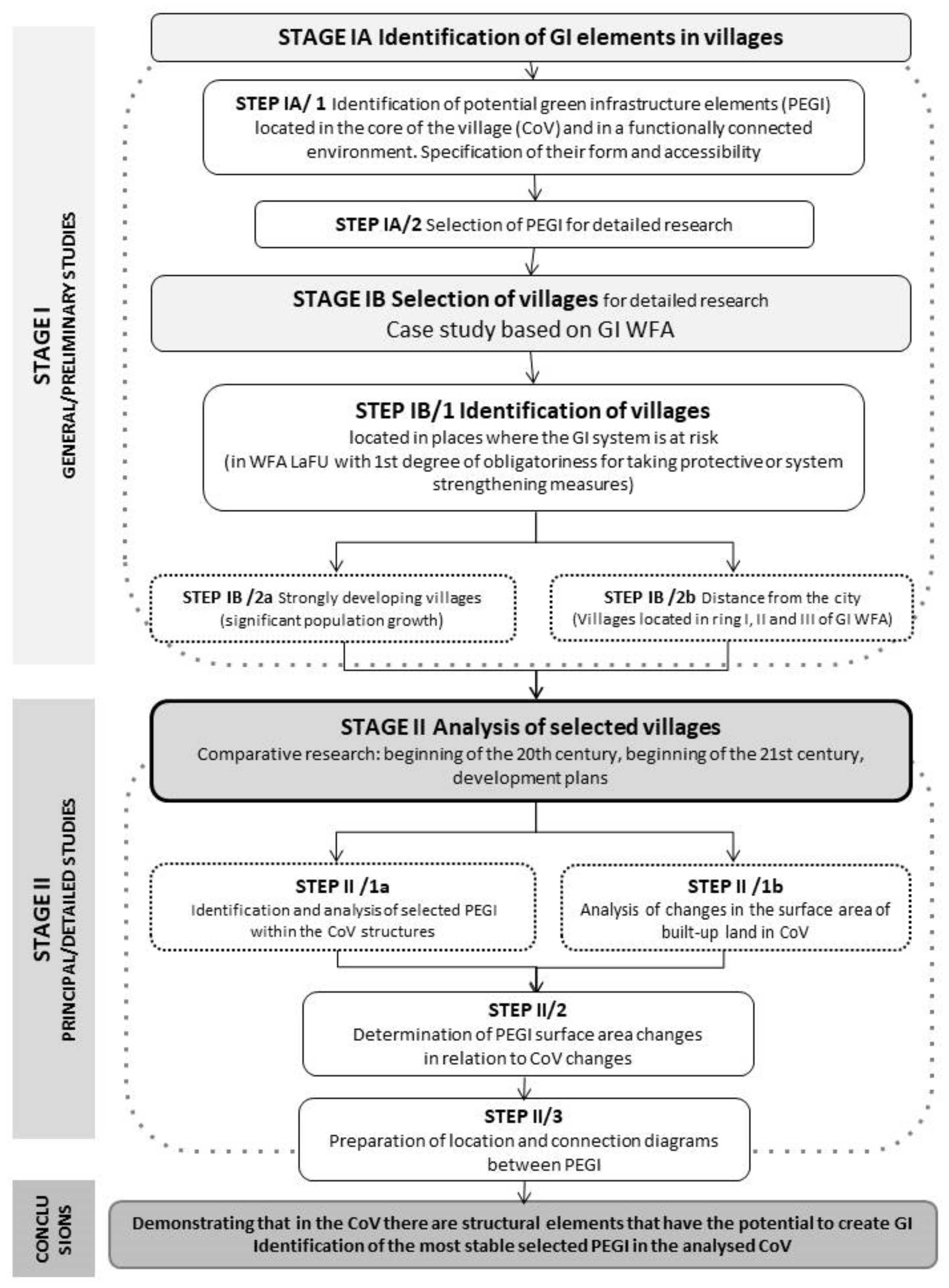
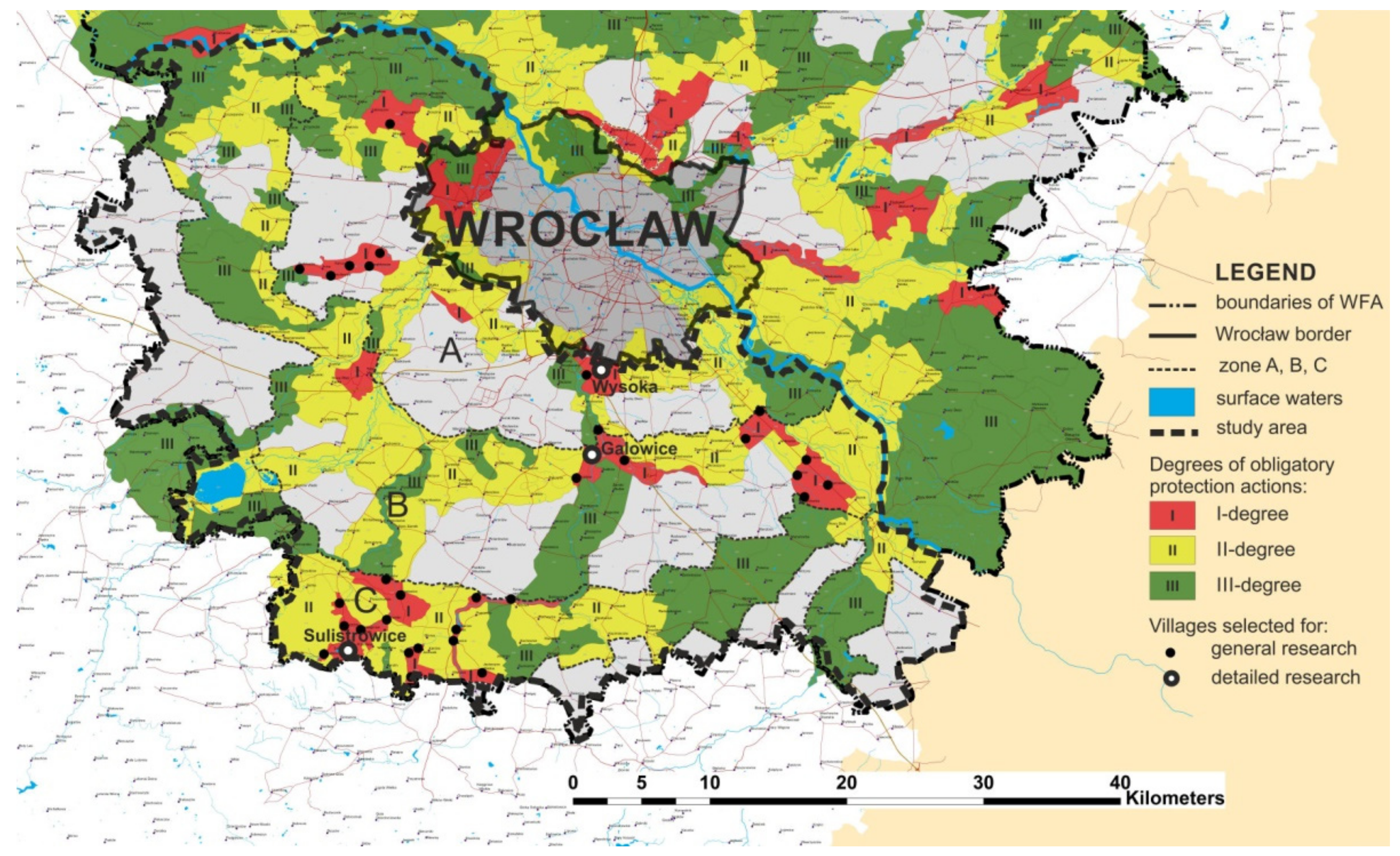
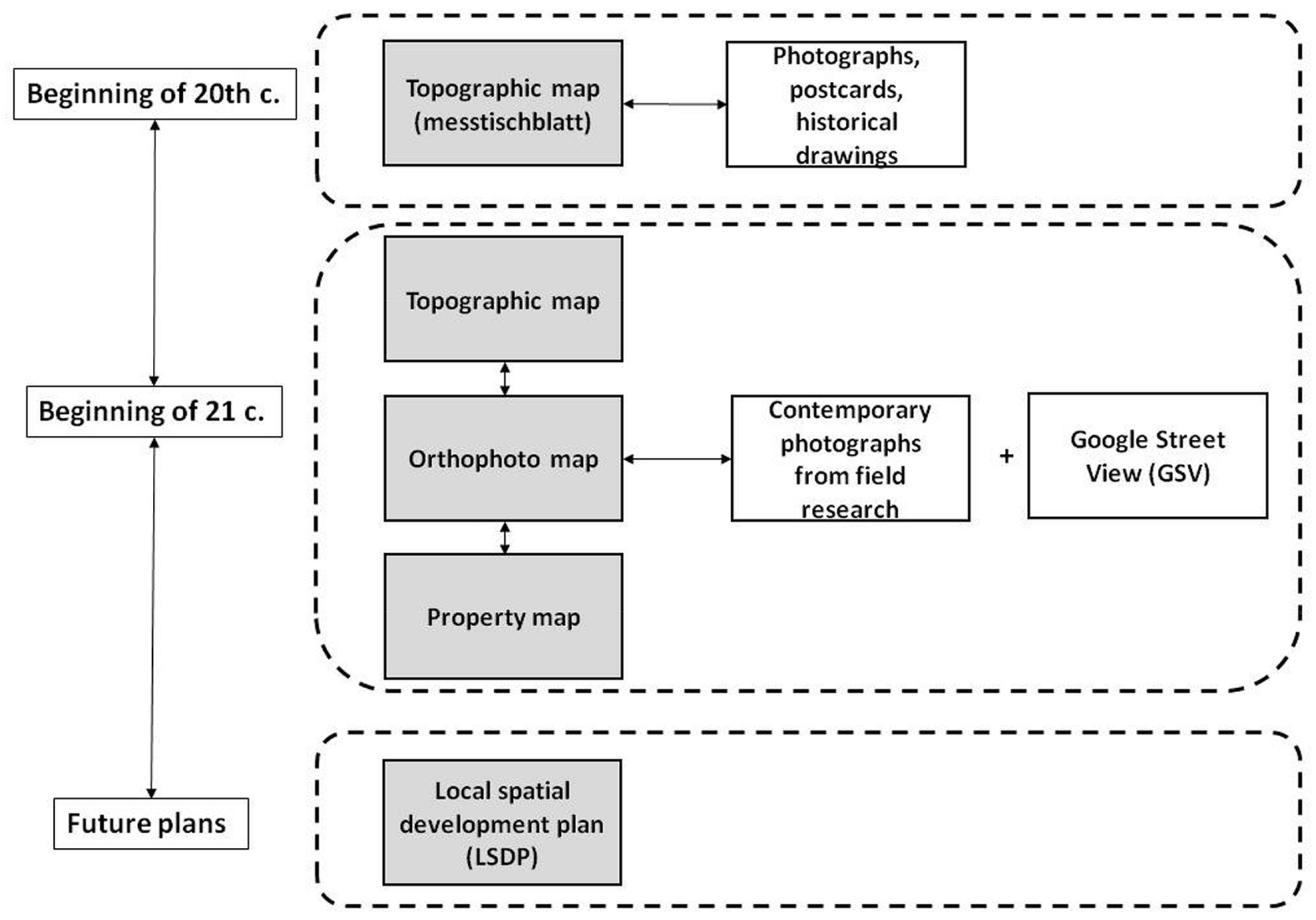
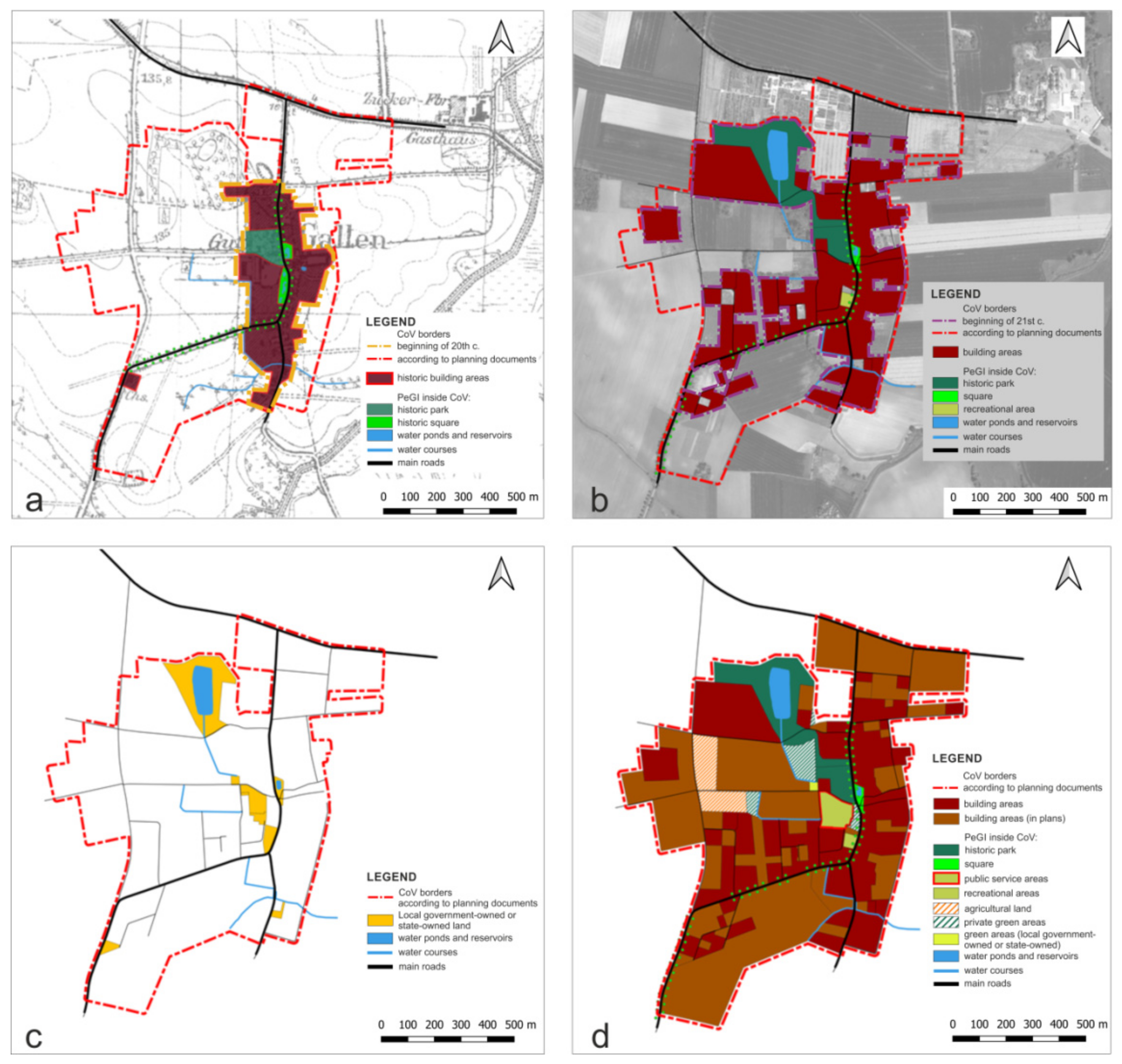
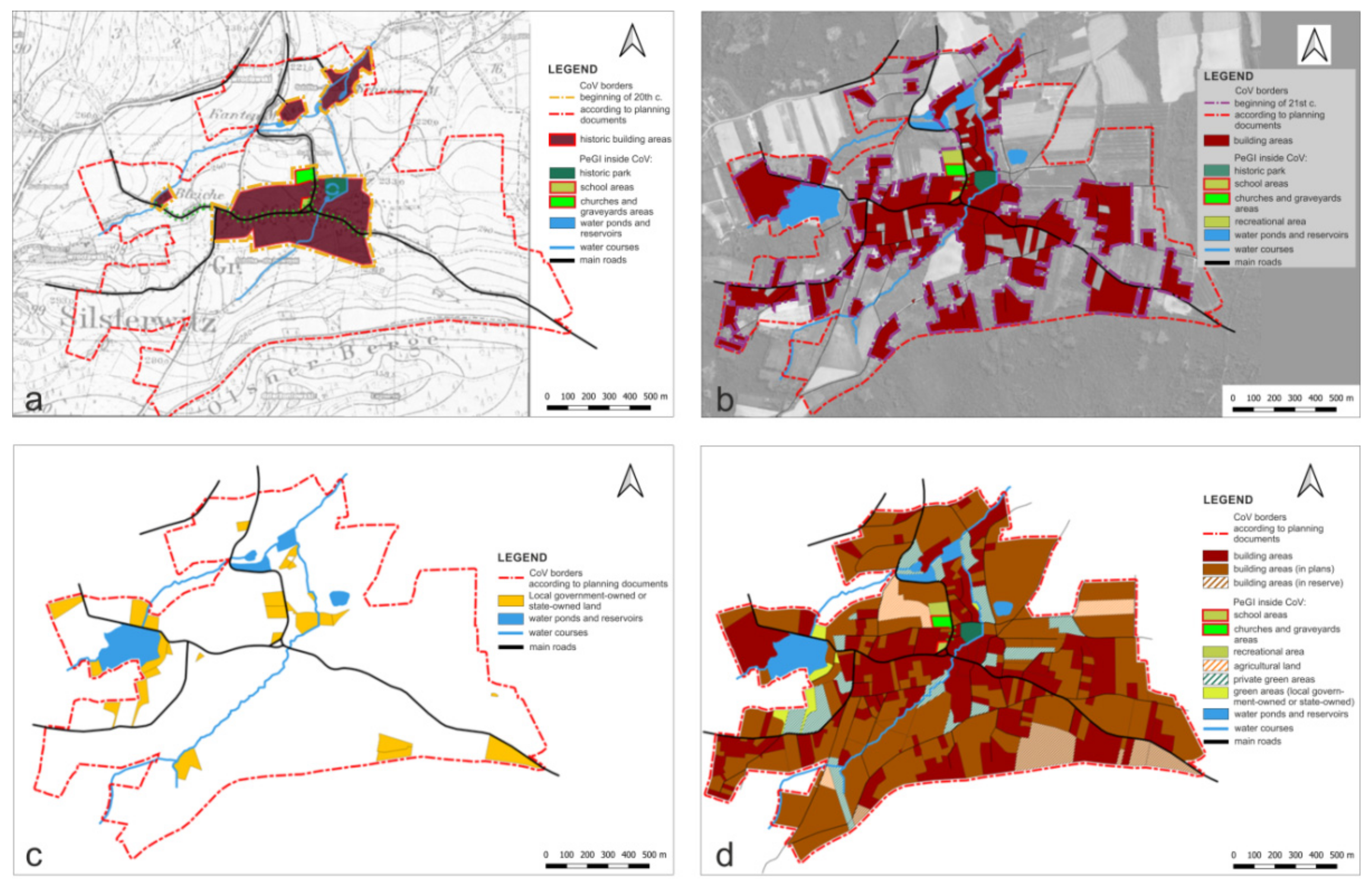
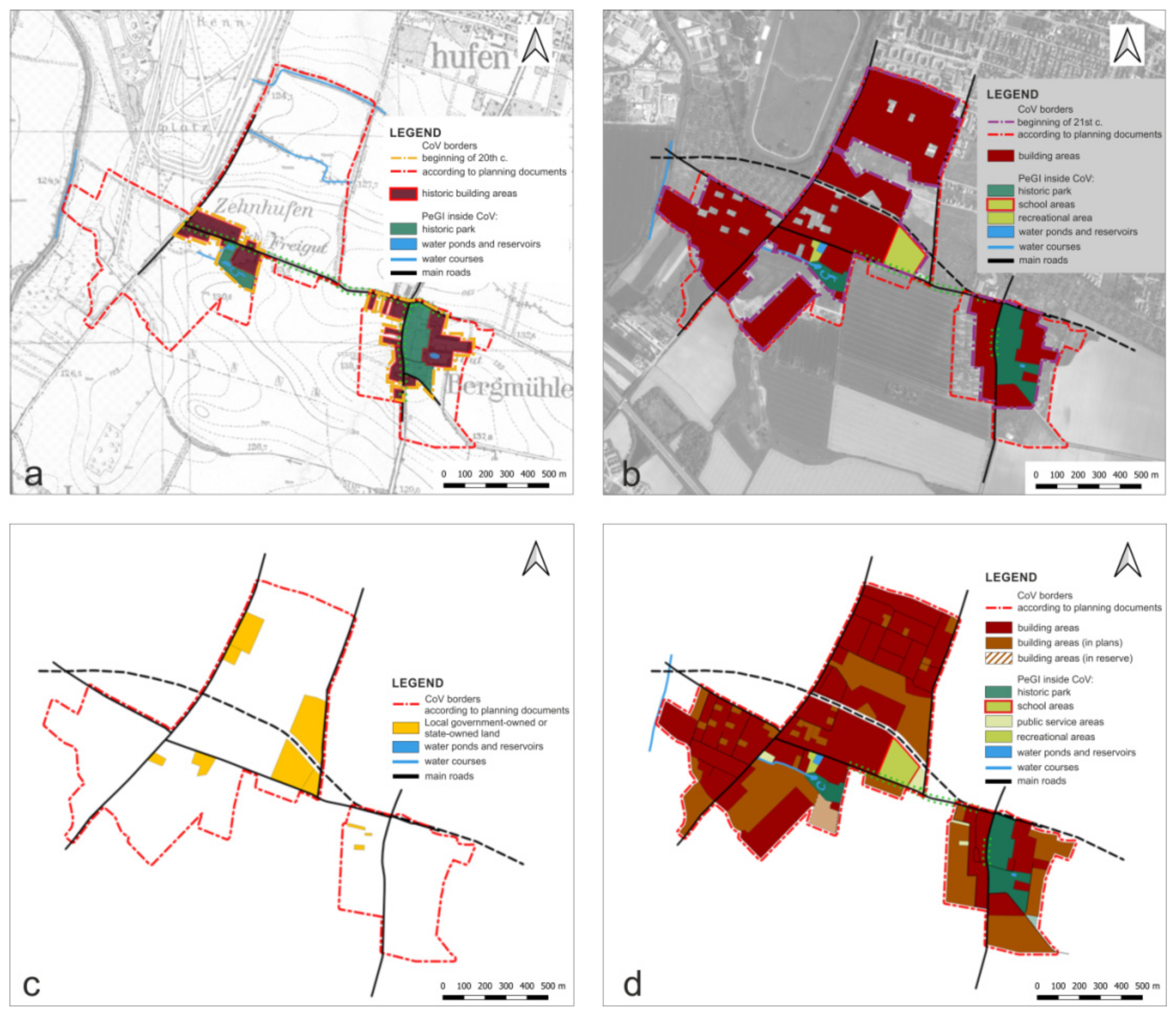
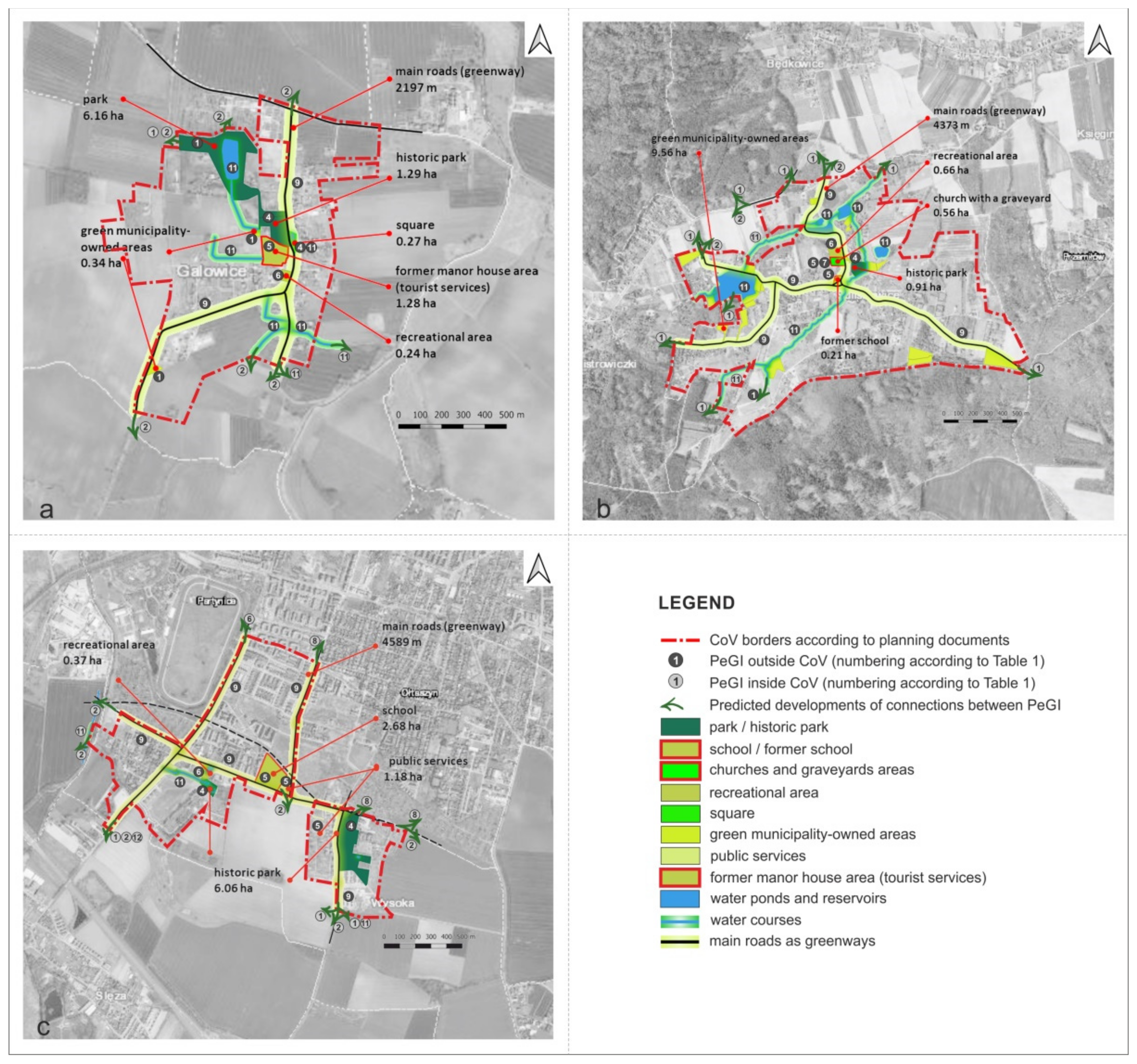
| No. | Potential Elements of Green Infrastructure (PeGI) | Location | Form | Accessibility/Ownership Possibility of Entering | |||
|---|---|---|---|---|---|---|---|
| Outside CoV (o) Inside CoV (i) Both (i/o) | Linear | Areal Type | Full | Partial | None | ||
| 1 | Natural and semi-natural areas not used for agriculture | ||||||
| 1a | Forests | (i/o) | X | X | |||
| 1b | Tree clumps, midfield greenery | (o) | X | X | X | X | |
| 1c | meadows | (i/o) | X | X | |||
| 1d | Wasteland (including abandoned orchards) | (i/o) | X | X | X | ||
| 2 | Agricultural land | ||||||
| 2a | Crop fields | (i/o) | X | X | |||
| 2b | Pastures | (i/o) | X | ||||
| 2c | Horticultural crop areas (including orchards) | (i/o) | X | X | X | ||
| 2d | Energy crops (trees grown to obtain biomass) | (o) | X | X | X | ||
| 3 | Mining areas and post-mining areas | ||||||
| 3a | Closed down raw material extraction areas (e.g., sand pits, gravel pits, clay mines, quarries) | (i/o) | X | X | X | X | |
| 3b | Operating raw material extraction areas (e.g., sand pits, gravel pits, clay mines, quarries) | (i/o) | X | X | |||
| 4 | Parks and squares | ||||||
| 4a | Palace parks and manor parks | (i) | X | X | X | ||
| 4b | Rural parks | (i) | X | X | |||
| 4c | Squares | (i) | X | X | |||
| 5 | Green areas accompanying public utility facilities/ | ||||||
| 5a | Areas next to places of worship (temples) | (i) | X | X | |||
| 5b | Areas next to schools and kindergartens | (i) | X | X | |||
| 5c | Areas next to administrative buildings and facilities | (i) | X | X | |||
| 5d | Areas next to cultural facilities (e.g., community centers) | (i) | X | X | |||
| 5e | Areas next to health and social care facilities (e.g., hospitals, sanatoriums, social care homes) | (i) | X | X | |||
| 5f | Areas next to tourist facilities (e.g., hotels, hostels and shelters) | (i/o) | X | X | |||
| 6 | Recreational and sports areas | ||||||
| 6a | Recreation areas | (i/o) | X | X | |||
| 6b | Sports grounds | (i/o) | X | X | |||
| 6c | Playgrounds | (i) | X | X | |||
| 7 | Cemetery | ||||||
| 7a | Operating cemeteries | (i/o) | X | X | |||
| 7b | Non-operating/closed cemeteries | (i/o) | X | X | X | ||
| 8 | Private gardens | ||||||
| 8a | Allotment gardens | (i/o) | X | X | |||
| 8b | Home gardens—front gardens | (i) | X | X | |||
| 8c | Home gardens—backyard gardens | (i) | X | X | |||
| 8d | Green areas at agritourism farms | (i) | X | X | |||
| 9 | Green areas accompanying communication routes (e.g., avenues, lanes of trees) | ||||||
| 9a | Along roads, streets | (i/o) | X | X | |||
| 9b | Along railway routes | (i/o) | X | X | |||
| 9c | Along bike routes | (i/o) | X | X | |||
| 10 | Others | ||||||
| 10a | Green roofs | (i) | X | X | X | X | |
| 10b | Green walls | (i) | X | X | X | X | |
| 11 | Water reservoirs | ||||||
| 11a | Lakes | (o) | X | X | |||
| 11b | Ponds | (i/o) | X | X | |||
| 11c | Water retention and fire protection reservoirs | (i/o) | X | X | |||
| 11d | Rivers, streams | (i/o) | X | X | |||
| 11f | Canals, ditches | (i/o) | X | X | X | ||
| 12 | Wetlands | ||||||
| 12a | Marshes/swamps | (i/o) | X | X | X | ||
| 12b | Floodplains | (i/o) | X | X | X | ||
| Village Name | German Name of the Village | Church | Cemetery | Palace, Folwark | Park | Population | Population Change | Location | ||||
|---|---|---|---|---|---|---|---|---|---|---|---|---|
| 1912 | 1988 | 2011 | % | A | B | C | ||||||
| Biskupice | Bischkowitz | X | 73 | 236 | 73 | –69.07 | X | |||||
| Karczyce | Kertschütz | X | X | X | X | 194 | 218 | 162 | –25.69 | X | ||
| Jarząbkowice | Schriegwitz | X | X | X | 138 | 201 | 151 | –24.88 | X | |||
| Jezierzyce Wielkie | Gr.Jeseritz | X | X | 318 | 245 | 185 | –24.49 | X | ||||
| Zabardowice | Seiffersdorf | X | X | X | 145 | 286 | 218 | –23.78 | X | |||
| Janówek | Ober Johnsdorf | X | X | 84 | 212 | 163 | –23.11 | X | ||||
| Tyniec nad Ślężą | Gr.Tinz | X | X | X | X | 633 | 711 | 564 | –20.68 | X | ||
| Kunów | Kuhnau | X | X | 117 | 150 | 126 | –16.00 | X | ||||
| Wilczków | Wiltschau | X | X | 499 | 439 | 393 | –10.48 | X | ||||
| Ramułtowice | Romolkwitz B. | X | X | X | X | 196 | 340 | 322 | –5.29 | X | ||
| Sulistrowiczki | Kl. Silsterwitz | X | X | 208 | 170 | 162 | –4.71 | X | ||||
| Strzegomiany | Striegelmühle | X | 311 | 415 | 398 | –4.10 | X | |||||
| Będkowice | Bankwitz | X | X | 338 | 204 | 199 | –2.45 | X | ||||
| Nasławice | Naselwitz | X | X | X | 485 | 217 | 213 | –1.84 | X | |||
| Księginice Małe | Kl, .Kniegnitz | X | X | X | X | 436 | 263 | 268 | 1.90 | X | ||
| Szukalice | Tschauchelwitz | 218 | 104 | 106 | 1.92 | X | ||||||
| Lizawice | Leisewitz | X | 272 | 154 | 159 | 3.25 | X | |||||
| Dankowice | Dankwitz | X | X | 155 | 229 | 244 | 6.55 | X | ||||
| Mrozów | Nippern | X | X | X | X | 1117 | 1265 | 13.25 | X | |||
| Budziszów | Polnisch Baudis | X | X | 64 | 266 | 304 | 14.29 | X | ||||
| Jordanów Śląski | Jordansmühl | X | X | 1038 | 1194 | 15.03 | X | |||||
| Zakrzyce | Sagschütz | 27 | 86 | 101 | 17.44 | X | ||||||
| Świątniki | Schwentnig | X | X | X | X | 248 | 212 | 252 | 18.87 | X | ||
| Tomice | Thomitz | X | X | 136 | 105 | 128 | 21.90 | X | ||||
| Ślęza | Lohe | X | X | 127 | 338 | 422 | 2485 | X | ||||
| Sulistrowice | Gr.Silsterwitz | X | X | X | 305 | 248 | 324 | 30.65 | X | |||
| Grodziszów | Rohrau | X | 91 | 77 | 101 | 31.17 | X | |||||
| Żórawina | Rothsürben | X | X | X | X | 1015 | 1625 | 2346 | 44.37 | X | ||
| Groblice | Grebelwitz | X | X | – | 250 | 325 | 476 | 4646 | X | |||
| Galowice | Gallowitz | X | X | 196 | 184 | 288 | 56.52 | X | ||||
| Piotrówek | Petersdorf | X | X | X | 137 | 118 | 211 | 78.81 | X | |||
| Marcinkowice | Märzdorf | X | X | 809 | 882 | 1724 | 95.46 | X | ||||
| Stanowice | Stannowitz | X | 706 | 424 | 861 | 103.07 | X | |||||
| Wysoka | Wessig | X | X | 132 | 477 | 2544 | 433.33 | X | ||||
| Galowice | Surface Area of Selected PeGI (ha) | Total Surface Area of Selected PeGI (ha) | Surface Area of Other Grounds Within CoV (ha) | Total Surface Area of CoV (ha) | ||||||
|---|---|---|---|---|---|---|---|---|---|---|
| Folwark Area (6a) | Historic Park (4a) | Recreational Area (6a) | Square with a Pond (4c) + (11b) | Green Municipal Area (6a) | Rural Park (4b) | Greenery of Private Plots in LSDPs | Built-Up Plots | |||
| Beginning of the 20th c. | 0 | 1.54 | 0 | 0.62 | 0 | 6.76 | 8.92 | 0 | 14.67 | 23.59 |
| Beginning of the 21st c. | 0 | 1.32 | 0.24 | 0.27 | 0.34 | 6.16 | 8.33 | 0 | 35.48 | 43.81 |
| Future plans | 1.28 | 1.29 | 0.24 | 0.27 | 0.11 | 6.16 | 9.35 | 2.03 | 82.41 | 93.79 |
| Sulistrowice | Surface Area of Selected PeGI (ha) | Total Surface Area of Selected PeGI (ha) | Surface Area of Other Grounds within CoV (ha) | Total Surface Area of CoV (ha) | ||||||
|---|---|---|---|---|---|---|---|---|---|---|
| Plot with a Church and Cemetery (5a) + (7a) | Plot with a School (Community Centre now) (5b) | Park (4a) | Recreational Area (6a) | Green Municipal Area (5) | Greenery of Private Plots in LSDPs | Agricultural Land | Built-Up Plots | |||
| Beginning of the 20th c. | 0.58 | 0.21 | 0.91 | 0 | 0 | 1.7 | 0 | 0 | 24.1 | 25.8 |
| Beginning of the 21st c. | 0.56 | 0.21 | 0.91 | 0.66 | 9.56 | 11.9 | 0 | 0 | 66.57 | 78.47 |
| Future plans | 0.56 | 0.21 | 0 | 0.66 | 2.07 | 3.5 | 13.79 | 5.72 | 182.5 | 205.51 |
| Wysoka | Surface Area of Selected PeGI (ha) | Total Surface Area of Selected PeGI (ha) | Surface Area of Other Grounds Within CoV (ha) | Total Surface Area of CoV (ha) | ||||
|---|---|---|---|---|---|---|---|---|
| Plot with a School (5b) | 2 Parks with Ponds (4a) + (11b) | Recreational Area (6a) | Green Municipal Area (5) | Greenery of Private Plots in LSDPs | Built-Up Plots | |||
| Beginning of the 20th c. | 0 | 5.83 | 0 | 0 | 5.83 | 0 | 10.03 | 15.86 |
| Beginning of the 21st c. | 2.68 | 6.06 | 0.37 | 0 | 9.11 | 0 | 65.14 | 74.25 |
| Future plans | 2.68 | 6.06 | 0.37 | 1.18 | 10.29 | 0.17 | 103.31 | 113.77 |
| Village Name | Surface Area of Built-Up Land (Residential, Service and Industrial Zones Without Areas Covered by the Analysis of Potential GI Elements) [ha] | |||||
|---|---|---|---|---|---|---|
| Beginning of 20th c. | Beginning of 21st c. | % Growth from the Early 20th Century to the Beginning of the 21st Century | Plans (LSDPs and Land Surveying Divisions) | Overall Plans (4 + 5) | % Growth at the Beginning of the 21st Century and Plans | |
| Galowice | 14.67 | 35.48 | 141.85 | 48.51 | 82.41 | 132.27 |
| Sulistrowice | 24.1 | 66.57 | 176.22 | 115.93 | 190.11 | 185.57 |
| Wysoka | 10.03 | 65.14 | 549.45 | 38.17 | 103.31 | 58.60 |
| Village Name | Period | Total Surface Area of Selected PeGI (ha) | Total Area of CoV (ha) | % Share of PeGI in CoV |
|---|---|---|---|---|
| Galowice | Beginning of 20th c. | 8.92 | 23.59 | 37.81 |
| Beginning of 21st c. | 8.33 | 4381 | 19.01 | |
| Plans | 9.35 | 93.79 | 997 | |
| Sulistrowice | Beginning of 20th c. | 1.7 | 25.8 | 6.59 |
| Beginning of 21st c. | 119 | 78.47 | 15.17 | |
| Plans | 3.5 | 205.51 | 1.7 | |
| Wysoka | Beginning of 20th c. | 5.83 | 15.86 | 36.76 |
| Beginning of 21st c. | 9.11 | 74.25 | 12.27 | |
| Plans | 10.29 | 113.77 | 9.04 |
Publisher’s Note: MDPI stays neutral with regard to jurisdictional claims in published maps and institutional affiliations. |
© 2022 by the authors. Licensee MDPI, Basel, Switzerland. This article is an open access article distributed under the terms and conditions of the Creative Commons Attribution (CC BY) license (https://creativecommons.org/licenses/by/4.0/).
Share and Cite
Niedźwiecka-Filipiak, I.; Gubański, J.; Podolska, A.; Rubaszek, J.; Witkiewicz, A. Potential Elements of Green Infrastructure (PeGI) Inside the Core of the Village (CoV): A Case Study of Wrocław Functional Area (WFA) in Poland. Sustainability 2022, 14, 1611. https://doi.org/10.3390/su14031611
Niedźwiecka-Filipiak I, Gubański J, Podolska A, Rubaszek J, Witkiewicz A. Potential Elements of Green Infrastructure (PeGI) Inside the Core of the Village (CoV): A Case Study of Wrocław Functional Area (WFA) in Poland. Sustainability. 2022; 14(3):1611. https://doi.org/10.3390/su14031611
Chicago/Turabian StyleNiedźwiecka-Filipiak, Irena, Janusz Gubański, Anna Podolska, Justyna Rubaszek, and Anna Witkiewicz. 2022. "Potential Elements of Green Infrastructure (PeGI) Inside the Core of the Village (CoV): A Case Study of Wrocław Functional Area (WFA) in Poland" Sustainability 14, no. 3: 1611. https://doi.org/10.3390/su14031611
APA StyleNiedźwiecka-Filipiak, I., Gubański, J., Podolska, A., Rubaszek, J., & Witkiewicz, A. (2022). Potential Elements of Green Infrastructure (PeGI) Inside the Core of the Village (CoV): A Case Study of Wrocław Functional Area (WFA) in Poland. Sustainability, 14(3), 1611. https://doi.org/10.3390/su14031611






